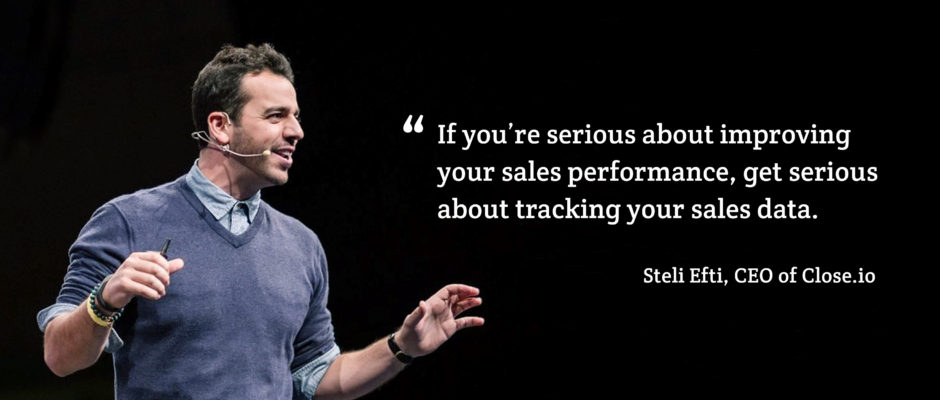Every salesperson wants to improve their sales performance, but no one wants to track their sales data.
But here’s the problem: Trying to improve your performance without data is like trying to fix a leaky faucet with a chainsaw.
Trying to improve your performance without data is like trying to fix a leaky faucet with a chainsaw.
Tweet this quote
You might get the job done, but you’re much more likely to tear the house down than fix the leak. You just don’t have the tools to get the job done.
For example, imagine you’ve only closed 3 out of the last 100 leads. Obviously something’s wrong. But if you aren’t tracking your data, how do you know where the problem is?
It could be your pitch, your close, the contact information, or your lead list. The problem could be anywhere and, without sales data, there’s no way to find it. And if you can’t find it, you can’t fix it.
If you’re serious about improving your sales performance, get serious about tracking your sales data. It doesn’t have to be hard or time-consuming.
In fact, all it takes are three metrics: Activity, quality, and conversion. Track those consistently, and you’ll be able to identify and resolve weaknesses in your sales process faster and more effectively than ever.
Sound good? Great. Let’s take a closer look at each metric.
Sales metric #1: Activity
The activity metric measures how much of a given task you do over a period of time. For example:
- How many cold calls did you make?
- How many follow-up emails did you send?
- How many trial users did you reach out to?
Activity tracks how and where your time is being invested, and lays the foundation for the next two metrics. Low activity rates usually mean you aren’t taking enough action.
Sales metric #2: Quality
The quality metric measures the quality of your activity and lead list to ensure you’re pursuing the right prospects. For example:
- How many decision-makers did you reach?
- How many of those decision-makers were qualified?
- How many of those qualified decision-makers were interested?
Quality measures the value of your leads. Low quality rates usually mean you have an outdated lead list or you’re targeting the wrong prospects.
Sales metric #3: Conversion
The conversion metric measures how many qualified decision-makers moved on to the next step in your sales cycle. For example:
- How many agreed to a demo?
- How many signed up for a trial?
- How many purchased your product?
Conversion measures the effectiveness of your pitch and close. Low conversion rates usually mean you either failed to ask for the close or didn’t demonstrate enough value.
Sales data in action
Numbers alone won’t fix anything, but they will help you identify where the problems are.
Tweet this quote
Okay, you’ve got your three metrics. But how do you actually use them to improve your sales performance?
Think of sales data as indicators. Numbers alone won’t fix anything, but they will help you identify where the problems are.
Let’s take a look at three examples of using sales data to diagnose weaknesses in a sales process.
Example 1: Leave a message after the beep
The situation: You’re calling 100 prospects, reaching 5, qualifying 4, and closing 2. With sales data, that looks like:
- Activity: 100 cold calls
- Quality: Reached 5 (5%), qualified 4 (80%)
- Conversion: Closing 2 (50%)
The problem: You have great qualification and conversion rates, but you’re only reaching 5% of the prospects you’re calling. You need to revise your outreach strategies.
Potential solutions: Call at a different time, send an email, or visit your prospects in person.
Example 2: Sorry, not interested
The situation: You’re sending 100 cold emails, getting 25 responses, qualifying 1, and closing 1. With sales data, that looks like:
- Activity: 100 cold emails
- Quality: 25 responding (25%), qualifying 1 (4%)
- Conversion: Closing 1 (100%)
The problem: You have great response and conversion rates, but only 4% of those responses are qualified to use your product. There’s a clear disconnect between you and your target market.
Potential solutions: Revise your ideal customer profile or buy a higher quality lead list.
Example 3: Rejection
The situation: You’re making 100 cold calls, reaching 25, qualifying 15, and closing 1. With sales data, that looks like:
- Activity: 100 cold calls
- Quality: Reaching 25 (25%), qualifying 15 (60%)
- Conversion: Closing 1 (6%)
The problem: You have great reach and qualification rates, but you’re only closing 6% of those qualified decision-makers. If they’re qualified, they should need your product. Your pitch clearly needs an overhaul.
Potential solutions: Create a sales script, revise your current documentation, or hire a dedicated salesperson.
Sales data benchmarks
If you’ve never tracked data before, you may not know when a particular metric needs improvement.
Use the numbers below as a rough guide to benchmark your performance. If you dip below these minimums, focus on improving that particular part of your sales process.
Keep in mind that every industry is different and these numbers aren’t 100% accurate. If they feel unrealistic for your business, create your own performance baselines.
Cold calling
- Reach rate: 15% of total called
- Qualification rate: 30% of total reached
- Conversion rate: 50% of total qualified
Cold emailing
- Open rate: 30% of total sent
- Response rate: 30% of total opened
- Conversion rate: 50% of total responses
The 2-week challenge
Still on the fence about sales data?
Try tracking these three metrics consistently for two weeks straight. Not sure how? There’s no “right” way, but here are a few options to consider:
- Manually, with pen and paper
- Digitally, with an Excel spreadsheet
- Automatically, with a sales CRM like Close.io (Hey! We’ve got a 2-week free trial!)
Whatever method you choose, just make sure you’re consistent. If you aren’t impressed by the results by the end of those two weeks, go back to the way you’ve always done it. But trust me—you won’t be going back.
About the author
 Steli Efti is the co-founder & CEO of Close.io, an inside sales CRM that allows users to make & receive calls with one click, automatically tracks all your emails, and minimizes manual data entry.
Steli Efti is the co-founder & CEO of Close.io, an inside sales CRM that allows users to make & receive calls with one click, automatically tracks all your emails, and minimizes manual data entry.
Want more by Steli? Sign up for his free startup sales success course.
